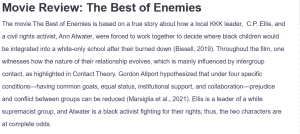Movie Review: The Best of Enemies
The movie The Best of Enemies is based on a true story about how a local KKK leader, C.P. Ellis, and a civil rights activist, Ann Atwater, were forced to work together to decide where black children would be integrated into a white-only school after their burned down (Bissell, 2019). Throughout the film, one witnesses how the nature of their relationship evolves, which is mainly influenced by intergroup contact, as highlighted in Contact Theory. Gordon Allport hypothesized that under four specific conditions—having common goals, equal status, institutional support, and collaboration—prejudice and conflict between groups can be reduced (Marsiglia et al., 2021). Ellis is a leader of a white supremacist group, and Atwater is a black activist fighting for their rights; thus, the two characters are at complete odds.
However, they are forced to interact as representatives of their communities so that the school integration issue can be solved. As they work together, they realize they have shared experiences and goals, which forces them to confront their perspective of each other. These interpersonal moments result in less prejudice because they realize that their social differences are but social constructs only used to justify oppression. Notably, Atwater was able to use her privilege as a leader of the black community to gain access to Ellis’s son and help him while he was in the hospital. Ellis, on the other hand, used his privilege to vote in favor of the integration of black students into white-only schools.
Moreover, this story can be described using the Social Identity Theory because before he quit being the president of the KKK and voted in favor of the black community, Ellis strongly identified with his in-group, the white supremacists. He was determined to see the purpose of his group fulfilled; however, as he worked with Atwater and learned more about black people, he saw the flaws in his in-group’s ideology, and hence, his identity began to shift. He eventually crossed the boundary of social identity, knowing that he valued shared humanity more than racial superiority.
Lastly, as a social worker with the goal of helping clients recognize their own strengths and resiliency to facilitate their personal empowerment, the best strengths perspective approach would be connecting them with needed resources like individuals or institutions. These resources would help facilitate personal empowerment, for example, by highlighting the client’s inner resources, encouraging self-reflection, and supporting the belief that change is possible.
References
Bissell, R. (Director). (2019, April 5). The best of enemies. STX Entertainment.
Marsiglia, F. F., Kulis, S. S., & Lechuga-Peña, S. (2021). Diversity, oppression, and change: Culturally grounded social work. (3rd ed.). Oxford University Press.
ORDER A PLAGIARISM-FREE PAPER HERE
We’ll write everything from scratch
Question
Readings:
- Textbook:
- Movie three – The Best of Enemies

Movie Review: The Best of Enemies
This time, we will focus on the year 1971, in Durham, North Carolina. Using Contact Theory, let’s explore how the two main characters found common ground through intergroup, albeit forced, contact. What experiences led each to reduce prejudices, create intergroup cooperation, and cross-group friendships? How did the main characters use their privilege?
Explore different theories from previous weeks and describe how one can be applied to the story (Select one: Narrative Theory, Social Identity Theory, Feminist Theory, Intersectionality Theory, Liberation Pedagogy).
The strengths or resiliency perspective states that human beings have an inherent capacity to grow and change.
How might you help clients recognize their own strengths and resiliency to facilitate their personal empowerment?

